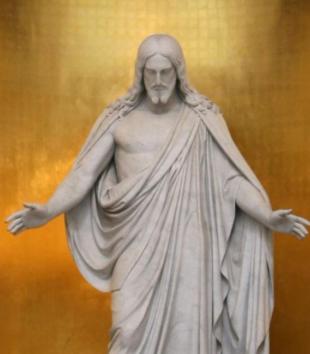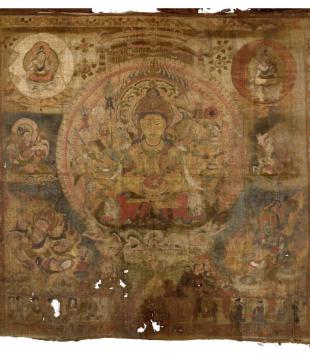Object Narratives explicate religious images, objects, monuments, buildings, or spaces in 1500 words or less.
Object Narratives
MAVCOR began publishing Conversations: An Online Journal of the Center for the Study of Material and Visual Cultures of Religion in 2014. In 2017 we selected a new name, MAVCOR Journal. Articles published prior to 2017 are considered part of Conversations and are listed as such under Volumes in the MAVCOR Journal menu.
 Gordon Parks, Dresser in the bedroom of Mrs. Ella Watson, a government charwoman
Gordon Parks, Dresser in the bedroom of Mrs. Ella Watson, a government charwoman
Visibly claiming to regulate the prescribed Christian imitation of the biblical figures they represented, late-nineteenth and early-twentieth century statues of light-complexioned religious figures populated domestic spaces, churches, and missions fields, and implied that looking like Jesus or Mary or John might be more “natural” or “complete” for some than for others.
 James Latimer Allen, Madonna and Child
James Latimer Allen, Madonna and Child
During the Harlem Renaissance, mother and child portraits and figure studies were especially popular in the African American media, signaling the importance placed on motherhood and the nurturing of future generations.
 Mark Rothko, No. 5/No. 22
Mark Rothko, No. 5/No. 22
Strong, gestural markings in the central red band distinguish this painting from Rothko’s other mature works. This anomaly consists of long, gently undulating lines formed by gouging the surface of the paint all the way to the canvas before it dried. Straining out from a central point, the horizontal lines contrast sharply with the fuzzy, indeterminate edges of the other elements of the painting.
 Ford Madox Brown, Work
Ford Madox Brown, Work
Ford Madox Brown’s allegory of labor in all its forms is the most ambitious Pre-Raphaelite painting of modern life and a profound meditation on the relationship between art, religion, and labor in Victorian society.
 Bertel Thorvaldsen, Christus (Christ)
Bertel Thorvaldsen, Christus (Christ)
The internationally famous Danish sculptor Bertel Thorvaldsen (1789–1838) was asked to produce a series of colossal statues of Christ, John the Baptist, and the apostles for the new Neoclassical Vor Frue Kirke of Denmark. Of these, Christus (Christ) has become best-known. Copies of the sculpture, often true to size or even larger, can be found around the world.
 Barquitos del San Juan: La Revista de los Niños, Year 13, No. 23, 2007
Barquitos del San Juan: La Revista de los Niños, Year 13, No. 23, 2007
Rolando Estévez Jordán, a visual artist, and Alfredo Zaldívar, a poet, co-founded Cuba’s Ediciones Vigía (Watchtower Editions) in 1985 to create an open forum for writers, musicians, and artists.
 Carte de visite Photograph Album
Carte de visite Photograph Album
What photograph albums teach us about nineteenth-century viewing habits is that the reach of religion extended beyond compositionally “religious” subjects. Modes of beholding were often forms of religious practice that did not require a regulated rift between sacred and secular.
 Alexander Anderson, Abigail Hutchinson: A Young Woman Hopefully Converted
Alexander Anderson, Abigail Hutchinson: A Young Woman Hopefully Converted
That “Protestants don’t have pictures” remains a common generalization. Yet in the early nineteenth century, nothing could be further from the truth. Protestant publishers like the nonsectarian American Tract Society (ATS) lavishly decorated their tracts with small but expressive printed illustrations.
 The Chapel of Our Lord of the Miracles (La Capilla de Nuestro Señor de los Milagros), San Antonio, Texas
The Chapel of Our Lord of the Miracles (La Capilla de Nuestro Señor de los Milagros), San Antonio, Texas
No exact date is known for the founding in San Antonio, Texas, of the Capilla de Nuestro Señor de los Milagros (Chapel of the Lord of Miracles), or Capilla de los Milagros, as it is sometimes called. Visitors to the shrine and its central Christ image offer both their orations and material expressions of prayer.
 Opening Virgin (Vierge Ouvrante)
Opening Virgin (Vierge Ouvrante)
This object is an example of a type of small-scale Christian moveable-part medieval sculpture called a Vierge Ouvrante (“Opening Virgin”).
 Traveling Image of the Holy Child of Atocha (Santo Niño de Atocha), Plateros, Mexico
Traveling Image of the Holy Child of Atocha (Santo Niño de Atocha), Plateros, Mexico
Each year, certain special religious images are ceremonially brought from Mexico and Central America to visit Catholic devotional communities in Southern California. These devotional statues of Catholic saints are “imágenes peregrinas,” pilgrim or traveling images.
 Arthur B. Davies, Sacramental Trees
Arthur B. Davies, Sacramental Trees
Two maidens, one bright and one shadowy, lead an ox through a curiously dense, shallow, and cubistically-fragmented woodland, heading (one presumes) through the titular sacramental trees and towards an uncertain destination.
 Drain-spout in the Form of a Flying Celestial Figure
Drain-spout in the Form of a Flying Celestial Figure
Hovering above the central courtyard of a Hindu monastery at the rural central-Indian village of Chandrehe was once a set of finely sculpted flying celestials, known within their original, tenth-century context as gandharvas, heavenly singers in the court of the gods, or vidya-dharas, meaning “carriers of truth.”
 Thousand-armed and Thousand-eyed Avalokiteshvara
Thousand-armed and Thousand-eyed Avalokiteshvara
Avalokiteshvara, one of the most important bodhisattvas in Buddhism, was popularly known as the “perceiver of the world’s cries.” Bodhisattvas, meaning literally “enlightened beings,” were devoted, out of a deep sense of compassion, to aiding other sentient beings in their quest for enlightenment, even to the point of postponing their own entry into nirvana.
 The Vincent and Mary Markham Monument
The Vincent and Mary Markham Monument
In the summer of 1900, Denver acquired an unusual sculpture to mark the last resting place of pioneer attorney Vincent Daniel Markham (1826-1895) and his wife Mary (ca. 1834-1893).
 Cuzco Miter
Cuzco Miter
The Cathedral of Cuzco, Peru holds several liturgical ornaments from the Spanish colonial period in its treasury. Among them is a magnificent embroidered miter, the headdress worn by bishops for blessings, baptisms, and processions.
 Kwame "Almighty" Akoto, The Supernatural Eyes of God
Kwame "Almighty" Akoto, The Supernatural Eyes of God
During a trip to Ghana in May 2010, I visited the roadside shop and atelier of painter Kwame Akoto, alias “Almighty,” a name he adopted so as to praise the power of God.
 Rightly Dividing the Word of Truth
Rightly Dividing the Word of Truth
Clarence Larkin’s dispensationalist chart “Rightly Dividing the Word of Truth” (1920) offers a detailed schematic of biblical history. The artistic product of an individual with experience in mechanical draftsmanship, Larkin’s chart shows how events and epochs fit together like parts in a salvation machine.
Icons move. They cross national borders and traditional boundaries. They show up in the least expected places.
 Ancestor portraits at Mogao Cave 231
Ancestor portraits at Mogao Cave 231
The integration of “secular” figures into a Buddhist cave complicates the separation established by both medieval Chinese authors and modern scholars of Buddhist art between practices of familial commemoration and religious devotion.
 Hans Holbein the Younger, Dead Christ Entombed
Hans Holbein the Younger, Dead Christ Entombed
“Why, some people may lose their faith looking at that picture!” Dostoyevsky famously had his fictional character Prince Myshkin exclaim over Hans Holbein the Younger’s Dead Christ Entombed.
 Skull boxes
Skull boxes
Skull boxes that both memorialized a dead individual and displayed the deceased person’s skull were made in Brittany from the eighteenth century to about 1900.
These glass eyes seem to look intently at the viewer, seizing the viewer’s attention. This is precisely what they are intended to do by the Shvetambar Murtipujak Jains of western India; it is also precisely why the Digambar Jains of western India strenuously object to them.
 The Virgin of Guadalupe, Extremadura, Spain
The Virgin of Guadalupe, Extremadura, Spain
This Marian icon cannot be characterized as a single object as the perception of her authenticity, from which she gains her numinous power, draws on two distinct representations, one nested inside the other.